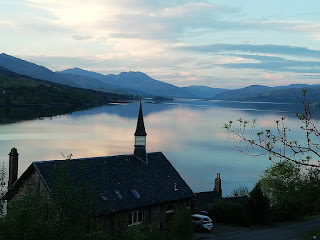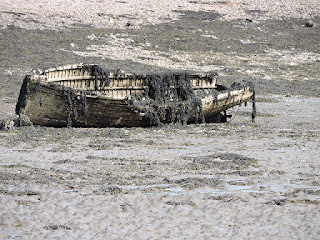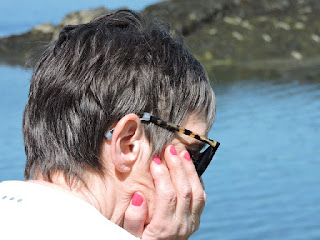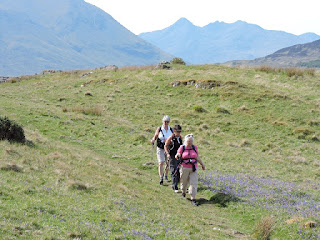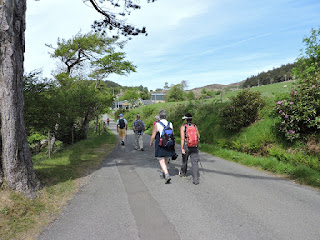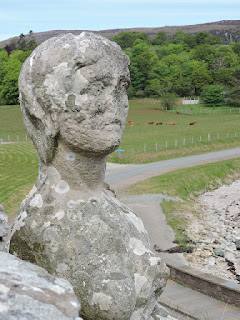STROMEFERRY (NO FERRY)
Yes! It is that time of year again and the Dinosaurs are off on holiday. This time we went to the West Coast, staying at the Stationmaster's Lodge in Stromeferry, which everyone should know, doesn't actually have a ferry any more. The ferry stopped operating in 1970, following completion of the Stromeferry bypass on the southern shore of Lochcarron in the same year. The bypass is notorious for rockfalls and closures and a ferry has occasionally operated when the road has been closed for extended periods.
As an aside I was told by a friend (yes, I do have one) that a travelling salesman working for the same company as this friend, claimed expenses for the ferry for years after it had stopped operating!
Stromeferry is also famous for something rather more exciting than a bit of fiddling the expenses. The railway station was the site of the Stromeferry Riot which is hard to believe when you see how peaceful and sleepy it is today.
However, in 1883, 200 fishermen took possession of the railway terminus to prevent the unloading of fish on a Sunday - the fishermen being strict Sabbatarians. This led to the involvement of the police and the army and questions were raised in Parliament!
This unruly past was not going to prevent the Dinosaurs going to have some fun, so we all loaded up and got ready to roll out west. As always, we had to take everything but the kitchen sink. In fact, we might have needed the 200 fishermen to unload the cars when we had arrived there.
As we headed west in a bit of a convoy, the weather became warmer and the skies became a bit bluer, hinting at a nice week ahead.
The scenery also got a bit wilder and more exciting.
Destination 1 was the golf club at Lochcarron for lunch and then, those nine of us who wanted, were to play golf. The other four were to go shopping in the mall at Lochcarron and to get the last few things that we needed.
The golf course was very picturesque - probably better to look at than some of the golf, but we all had a great time in the sun, especially me. By some sleight of hand and a miracle of the handicapping system, I was the best man. Susan, by virtue of skill and endeavour, was the best woman. None of us was required to play any shots from the churchyard. Apparently this has been done despite it being out of bounds. It is common to suspend play while a funeral takes place.
The church is quite a plain, but a nice building which dates from 1836. It was originally known in Gaelic as An Eaglais Mhor - the big church. Despite that, nobody managed to hit it with any golf balls.
Here we are, ready to go.
Not many first greens have a setting like this.
The ladies walk off after finishing their duel in the sun.
Once we had all recovered from our exertions, we headed round the south side of Lochcarron to our home for the next few days, the Stationmaster's Lodge.
After a little while everything was unpacked and in the fridge or the bedrooms and it was time for the ladies to sit in the sun with a gin and tonic. They didn't need asking twice and, indeed, were so desperate, that they just sat down in the middle of the road. Thank goodness it was not a Sunday.
The views were just astounding and the peace and quiet, pervasive.
It wasn't always like this, of course. On the opposite side of the loch sits the ruin of Strome Castle. It was built in the 1400's and was a stronghold of the MacDonalds, who fought with the MacKenzies over the castle for years. In 1602, the castle was besieged by the MacKenzies, who, after a long siege were about to give up and leave. One of the MacDonald women accidentally poured water into a barrel of gunpowder, rather than the water barrel. Naturally, she was scolded rather loudly for this. Meanwhile a MacKenzie prisoner escaped during the furore and advised the besieging army that the castle was defenceless. The MacKenzies took over the castle and later blew it up and this is how it looks today.
Luckily there were no such mishaps with our dinner that evening. We had a Greek feast prepared by Jim, Jacque, Dave and Sandra. We started with olives and ouzo, before we got to the Moussaka, lemon chicken and salads. Pudding was honey cake, walnut loaf, yoghurt with honey and walnuts and then baklava with coffee. Not a smashed plate in sight.
A really good culinary start to our break - well done to them all.
Whilst the culinary team cleaned up, most of us went for a short walk down to the pier and a little way up the single street, to see what we could see.
There were nice views up the loch towards Lochcarron.
The sun was going down and everyone was out for a look.
Hugh was reverting to childhood, skimming stones across the very calm sea.
We walked up the road a bit and spotted this otter swimming across the far side of the loch - a bit too far away to get a good picture.
From further up the road, there was a great view up the loch over the little church.
A bit like Lake Bled, only salt water rather than fresh and there was the odd midge.
A fine end to the day and the promise of fine weather for tomorrow.
Day 2 Plockton and the Ice Cream scandal.
Sure enough, Tuesday dawned sunny, bright and warm. Maureen and Sharon decided to take in the sun while they waited for their breakfast to be cooked for them.
Happily this is not a video, or we would have heard them singing Three Little Maids from the Mikado!
Charlie and Sue had checked out our walk for the day, which was to be around Plockton and Duncraig Castle. We had an unscheduled walk out to a tidal island. We walked down the jetty onto the mud and seaweed. I reckon the jetty was built in 2004.
It looked a bit wetter than it actually was but it was worth it to get to the island.
Once we had checked it was safe to go out, Hugh, Sue and Pam followed over, safe in the knowledge that they were not going to get swallowed up by quicksand.
It was at that point that I wandered off to the far side of the island and everyone else decided to abandon me! It was very peaceful and sunny and there was a little seat to take in the view.
Thrift, which in the language of flowers means sympathy, which was clearly not in abundance, as they left me on the island on my own.
In Gaelic, Thrift translates as tonna chladaich meaning beach wave, which I quite like.
So I waved farewell to my little bit of island beach and crossed back to the mainland to catch up with everyone else.
We set off on the walk proper, climbing up on the road out of the village. In doing this we witnessed the difference between the Highlands and the rest of the country. The mobile bank drove up to the school and, without stopping, grabbed a bag of school dinner money from the head teacher. True mobile banking and an illustration of trust that you don't see very often elsewhere.
We were soon off the road, walking round the head of the bay and across to the other side.
Pam saw this and claimed it looked like some sort of animal's head and demanded that I take a photo to include in the blog, so here it is.
Not sure, Pam, not sure at all.
We walked right along the coastline.
Looking across to the village.
Even Jimmy would struggle to repair this boat.
There are Rhododendrons everywhere.
We passed under the railway line.
There are still primroses about.
As well as bluebells which you could smell everywhere.
Lots of wood anemones.
Blue common dog violet. They are apparently called dog violets because they have no scent. Not sure why that should be - dogs can be pretty smelly.
Lesser Celandine.
We gathered together to hear Sue tell us about all the things we had passed and those we were about to.
This, I think, is Hammered Shield Lichen. We had been commenting how clear the air must be to support so much lichen. Apparently this one is very tolerant of pollution, so maybe the air was not as clean as we thought!
A bridge and tree trunk photo.
The railway line runs through some tidal areas and there are little culverts and drains like this one to let water flow in and out underneath the tracks.
We came across the remains of a fairly substantial building, probably a house. The two gables are standing along with a double sided massive chimney stack. Unfortunately, I cannot trace any information about the building.
Further on the path, we got a photo of these lovely blooms along with the girls.
And the boys.
We also came across this chimney. This is brick built and might well be for railway workers. In common with road workers in the past, workers would set up portable lean-to huts against the chimney, so that they could have heat and shelter while they stayed out for one or more nights attending to maintenance of the railway.
Another lesson from Sue, flanked by her minders.
What does the sign say? Charlie took it literally and stopped on the tracks. Given there are only four trains running in each direction every day, this was not such a big risk.
We all made it across safely.
Which was just as well, because the path took us to this lovely grassy area next to the sea where we had our picnic lunch in the sunshine.
It was very warm and Jacque gave in to temptation and closed her eyes for a few minutes. She was quite lucky not to fall into a deep sleep and roll down the bank into the sea.
We had nice views from our picnic site over to Plockton.
After lunch we carried on round, heading all the time to Duncraig castle. We were still walking alongside the railway line.
The intention was for us to get to Duncraig railway halt and for me to get a picture of the Dinosaurs on the bridge over the line. Great idea - except the parapet was just a bit too high for some of our smaller members.
Whilst I was down at the station failing to get the right photo, I had the opportunity to investigate the station buildings.
There are not a lot of them to look at. This is it, in fact. The hexagonal wooden shelter is original and dates to 1897 and was built to serve the castle.
It is still open to the public and the original wood paneling is in place. It really is very dinky indeed.
Robin also had a look.
'Tis but a short walk from the halt to Duncraig Castle and what a magnificent building it is. Perhaps a little over the top, but you cannot help but be impressed.
The castle was built in 1866 for Alexander Matheson who was a China trader and MP. He had extensive interests in Hong Kong and he was a bit of a lad, let me tell you.
He was thought to have made a vast fortune from the opium trade and was a partner in the famous family firm of Jardine Matheson. At one time he was a Director of the Bank of England. He was also a railway entrepreneur and was heavily involved in the Highland Railway. He was less successful as a farmer and became better known for developing property. He had already bought up large swathes of Wester Ross, before he bought the feudal barony of Lochalsh. This included the site of this castle as well as the more distant and now widely famous Eilean Donan castle which has adorned so many shortbread tins.
Among his property developments were Ardross House and Ardross Street in Inverness.
He rather more controversially, evicted many of his tenants from Easter Ross. His actions led to riots at Plockton and he employed extra guards on the Highland railway line and sacked all his employees involved in the protests.
The Matheson coat of arms on Duncraig Castle has the motto Do and Hope. It seems he did and his tenants had no hope.
Bizarrely, there is a stuffed leopard in one of the windows.
This stone obviously commemorates the building of the castle, but it also records that AM and EP were married. Alexander Matheson married his third wife, Eleanor Perceval in 1860. They had 8 children. It would appear that he attacked married life with the same gusto as the rest of his life.
The castle was bequeathed to the County Council in 1945 and converted to a Domestic Science college after the war. It closed in 1989 and was owned and used by a succession of people until the current proprietors bought it in 2009. They have made many improvements and ultimately intend to open it as luxury holiday accommodation later this year. Given the views from the grounds, you can see the attraction.
The quite nicely restored stables apparently house the owner's fleet of luxury cars.
As the castle is not yet open to the public, we walked down the drive past the sign which will direct future tourists to a very smart place.
There were one or two odd sculptures in the woods.
This is the sign over what was the estate offices. I'm not sure why we need to be frightened of fish.
Just round from the offices was an open water tank fed by a stream running underneath a tree.
Quite amazing - I have never seen anything like it before.
We joined the public road for a little while and that afforded us some fine views over the sea.
We soon rejoined the outward path and this took us back to the village. Just on the outskirts was this arch which leads into the famous Plockton open-air church.
This is one of a number of such outdoor worship sites that came into being after the Disruption of 1834. That was when the Church of Scotland split over the issue of whether parishioners or landowners should choose ministers. Landowners refused to sell land for the new Free Church to build churches and so, outdoor places of worship were used.
This one has the archway and stone pews set out around the perimeter. It attracted hundreds of worshippers in its time. It remained in use until the 1930's.
Jimmy, giving a fairly accurate imitation of a Wee Free meenister.
The congregation is less solemn than they should be.
Robin takes a pew.
The Meenister leaving the church.
Duncraig Castle from the village.
It being so hot, ice cream was the order of the day.
In fact, at vast expense, Pam bought up all the ice cream that was available for our dinner that evening and there was none for the rest of the visitors to the village.
After we had our ice creams, we had a little wander around the village.
Plockton manages to combine the Highland ...
....with the continental.
Then it was back to Stromeferry for a change of clothes, a freshen up and, of course, dinner. This time it was Hugh and Pam and Sue and Charlie that created our feast.
We had a nice little cold meat starter followed by a choice of pork fillet in a Calvados sauce with mini scones or tomato chicken and couscous. For pudding, there was a very expensive ice cream to go with salted caramel tarts and a tropical fruit salad.
There was also a birthday cake for Jacque and Maureen who had recently celebrated special birthdays.
After dinner there were games and general raucousness before we all retired to bed.
Day 3 Raasay
An early start today and, once again the sun was shining on us all.
We needed the early start as we had to drive to Sconser on Skye and then get the ferry to Raasay. As we waited on the ferry coming, we had time to look at the local scallop diver's van on the pier, ready to take the mythical King Scallops away to a myriad of restaurants on the island.
Sharon, Jacque and Sue kept their eyes peeled in case the ferry came and went without us.
The rest of us sat in the sun and waited patiently.
Unfortunately, the ferry ran aground and we didn't get onto the island at all.
That wasn't actually true, it just looked like it.
We were soon on the sun deck, most of us overjoyed that our bus passes meant we did not have to pay.
Maureen forgot that she was not at playgroup any more and did not have to ask to go to the toilet.
On our approach to Raasay, we got a good view of the old Iron Ore workings. These date from the First World War. The workings and, indeed, the bulk of the island, were owned by William Baird and Co of Coatbridge. They sought to extract iron ore to support the war effort. The mine did operate, but on a smaller scale than originally intended. In 1916, Bairds signed a deal to run the mine for the Ministry of Munitions and the mines were worked by German prisoners of war, many of the original workers having joined up to fight at the front. The village of miners' houses were turned into a prisoner of war camp by surrounding it with barbed wire and putting up arc lights and sentry boxes.
The mine closed in the early 1920's.
Our first sighting of Raasay House. The island was home to Clan MacSween but was owned by the MacLeods, who built a house here as early as the 1500's. That house was burned down by government troops following Culloden as the islanders had supported the Jacobite cause. Work started on the present house in 1747.
There are two well endowed mermaids waiting to greet you as you get off the ferry from Skye. They were allegedly bought by MacLeod of Raasay to stand at either side of the entrance to Raasay House. Some say they were too heavy to take to the house and so were placed here. Other reports suggests that MacLeod found them too ugly to sit by his fine house and he would not have them.
We were not here to see mermaids, ugly or not, but to do some walking, so we set off round the bay from the pier before the ferry had even returned to Skye.
This stretch of coastline was a bit rugged, but quite beautiful and interesting. So interesting, in fact, that I decided to investigate it very closely when my laces tangled in my boots and I fell flat on my face. Nothing was hurt more than my dignity. 64 and I have had my first fall.
The views were spectacular.
We watched a scallop dredger work the Sound of Raasay.
Susan was enquiring of Sharon whether the environmental damage caused by such dredging fatally upset the balance of sustainability between fishing communities and traditional fisheries? Her answer is not recorded, but she thought about it for some time.
Meanwhile Charlie thought he was King Kong.
We walked through swathes of bluebells, which indicated that, at one time, there was much more woodland on the island than there is now.
More belles.
Bluebells and Rhododendrons, a real reminder of this trip.
Over the bluebells to Skye.
A fairly dehydrated frog, who probably didn't expect the sun to be quite so hot.
We had to walk through the rhoddies and Charlie was first. That gave him the opportunity to hide in the bushes and leap out in front of the ladies causing consternation and not a little screaming and giggling.
He was followed by an alien, or was it Sue with her sunglasses on the top of her head?
I'm not convinced there was a launderette here.
There was a heron, though.
There was also a shingle beach. The two dots are Dave and Jimmy going it alone.
Everyone else took the grassy route.
You got fabulous views which made the grassy bit more attractive than walking along the shingle beach.
Although, the seaward route wasn't too bad either.
Sharon also took the low road.
The high road allowed you to see these amazing old field drains.
The coastline here is pretty rocky and on the rocks grow lichens. You can see the different types of lichens here. Where the rocks are underwater at high tide you get black verrucaria lichens, further up are the grey and orange lichens. The very light grey ones are those that are the driest. Orange ones tend to be light loving lichens. Generally speaking the brighter in colour they are the more light they get.
An old dwelling and kail-yard.
This was abandoned almost certainly because of the mermaids at the ferry terminal. The mermaids represented the last straw for the fortunes of MacLeod. He soon sold the island to George Rainy from London for 35000 guineas and then emigrated to Tasmania.
Not long after Rainy became owner, the potato harvests failed and he decided sheep were a more profitable option, so he cleared the tenants from the land. Remarkably he also banned his tenants from marrying! Two boat loads of emigrants left for Australia in 1854. Another 165 souls left the island in 1865.
He sold the island to Edward Wood, who also ran into conflict with the tenants and he got out of sheep and into sporting, which required even fewer people.
It may be poignant, but it is absolutely beautiful. Robin reminded me that cleared crofters often built a cairn at the place where they could last catch sight of their homes, with each person placing a stone in turn. If they ever came back, they would know they were close to home and they would take a stone back with them to rebuild their lives. Of course, most of them never came back.
In 1803 nearly a thousand people lived on Raasay. In 2011 (the last census) there were 161. In 2001 Raasay had the lowest percentage of children on any inhabited Scottish Island.
As if to emphasise the loss of people, the rocks look almost like long abandoned Easter Island sculptures.
We moved away from the coast and started to climb a little towards the public road.
It was lined with bluebells.
We had to pass through planted coniferous woodland.
These are a legacy of the time when the island was owned by the government. They had bought it after Bairds gave up mining in 1922. That may have been a reaction to events in 1921, when a group of crofters from the island of Rona to the north of Raasay, tried to reclaim lands that their ancestors had been cleared from. They were arrested, tried and convicted and were jailed. Such was the outcry that the "Raasay Raiders" were freed and allowed to remain on the island.
In 1949 the government granted land to the Forestry Commission and the subsequent planting and associated works brought much needed employment to the island.
There were fine views through the Scots Pine to the sea.
We walked through some felled plantation which was less than pretty hence no photos. This took us to Orchard Wood, named after the enclosed orchard for Raasay House. There is no orchard behind the wall these days, but there is a house at the far end. The wall is a thing of some beauty and craftsmanship. It also offered a bit of shade.
The felling of the woods is not pretty, but it has opened up Loch na Muilneadh - Loch of the Mill, but locally known as Home Loch. There is a mill in the village, but it does not seem to be fed by this loch, so there must have been another mill at one time.
The signpost offered an alternative to our route called Temptation Hill. Naturally we resisted because there was a hill involved. I needed to know why it had that name. Apparently, it is all about a Kelpie who was lured to the top of the hill by the wondrous smell of a roasting pig. When the Kelpie got there it was slain by a blacksmith whose daughter had been devoured by the Kelpie earlier.
No roast pork for us, but there were some excellent egg and tomato rolls.
Lunch and a fabulous view across to Skye.
Near our lunch spot was this little graveyard, which we did not visit, but Dave ran up the hill for a look. He neglected to take a photo of the memorial stone for two German prisoners of war. They had been working at the iron mines during the First World War and had died. They were buried just outside the cemetery and the place is marked with a large stone which their fellow prisoners had dragged from the beach two miles away.
Slightly further down the track was the ruin of Dun Bhorghadail, an Iron Age Broch, which is a little unusual in that it is elliptical in plan form rather than circular. This may be due to the underlying ground contours, rather than a specific design. The Iron Age in Scotland runs from about 700 BC to 500 AD, so it is at least 1500 years old.
Robin and Jimmy went for a look, but could not confirm the age of the structure. It is in very poor condition, apparently.
A little bit downhill was the plain Free church building.
This is the old Free Church manse, which is now available to rent as holiday accommodation - it sleeps up to 12 if anyone is interested.
You actually get a better view of the broch from the church.
Although plain, the church is quite attractive.
From the church, it was a short walk to the public road, where we had an opportunity for a group photo.
We soon turned off the road and onto the Emigrant's Trail. There are details of the boats that carried emigrants from the island to Canada and Australia in the mid-1800's. Unfortunately, it has proven impossible for me to find out any further details, which is a bit of a shame as the plinths provided are impossible to read.
At the end of the trail we rejoined the road, passing by an old mill, which the community is hoping to restore.
Off up the road we went towards the new Raasay distillery.
It is very new, indeed.
It only started in 2017, so it will be a while before we can taste the results of the distiller's craft. I quite like the design, though.
Next stop was for a drink, but tea or coffee, not whisky.
We were able to sit out for afternoon tea in front of Raasay House, which is owned by the community. In many ways this represents a sort of renaissance for Raasay and its people. It was not an easy journey, however.
The House and other properties were purchased in the 1960's by the notorious Dr Green from Sussex. He visited the island only once and prevented all sorts of development initiatives and this earned him the nickname of Dr No.
What he bought for £6000, he sold to the Highlands and Islands Development Board for £135000 in 1979.
The House was purchased by the community in 2007 and renovation and refurbishment began the next year. It was all but gutted by fire weeks before the contractor was due to hand it over to the community. It was insured, so work began again. The builder went into liquidation in 2010. A new contractor was appointed in 2011 and the cafe opened in April 2013, with the first guests staying a few days later.
It is a beautiful building.
It also has a fabulous view.
You can sit and have your tea and watch the ferry come and go, because that is what ferries do. So we did and then, when it was time, we wandered down to the pier to get the boat back to Skye.
The mermaids seemed to be sad to see us go.
Hugh seemed to be quite happy to stay.
Then it was back to Stromeferry for a colourful Caribbean style dinner.
We had Whack me Bottom cocktails then spicy prawns as a starter. Mains were a Caribbean beef casserole with rice and jerk chicken with sweet potatoes. Pineapple Crumble with expensive ice cream was for pudding.
After games, we all went to bed, satisfied with our great day on Raasay.
Day 4 Attadale Gardens
Time for a group photo in front of the house before we left.
It wasn't far to the gardens and we were soon entranced by the peace, quiet, tranquility and beauty of our surroundings. There was no-one to take our money and we set off to look at the gardens and to keep an eye out for a gardener to pay, as instructed by the notice at the entrance. Before we got too far, the owner found us and took our money and off we went again. We started at the little pond, which was a nice place to start.
The gardens we can see today are not what they once were. They have changed significantly over time. Attadale House was built by Donald Matheson in 1755. Not a lot is known about the gardens associated with the house when it was first built, although it is thought that some of the largest trees are from that time.
The garden now is really the creation of the owner's mother, Nicky, who died in October last year, but she did not start with the 1755 plantings as her basis. You will have to read on to find out more.
Today's garden does have a bit of a reputation for its Meconopsis.
The Monet type bridges are a bit of a signature of the gardens.
I'm not sure one water lily makes a Monet painting, but then this lot are no oil painting either.
Much more decorous.
A bronze Heron, one of many sculptures to be found throughout the garden. The sculptures were the inspiration of Nicky and the ponds were her way of using the holes left by the root plates of fallen trees.
The originator of the house and garden, Donald Matheson, was a forebear of Alexander Matheson who built Duncraig which we had visited earlier in the week. In the 1880's Attadale was leased and then sold in 1910 to Baron von Schroder. He had a bob or two, being of the Shroder investment banking family. It was he who planted rhododendrons and many of the large trees that are still here now.
Here we are admiring the view and discussing whether the 19th Century drum tower in the left re-entrant is an appropriate addition.
The Crowned Eagle was above comment on that.
It also does not take its eyes off you.
Maureen and Sharon seem unworried, though.
I really like this juxtaposition of the tree and the bush, like mother and child.
The front of the house. Only the central part is the original 1755 building.
The Baron's son, Wilhelm von Schroder took British citizenship in 1912 and joined the army, where he was known as Captain Billy Schroder. He died in 1945 and the estate was sold to Martin Gibbs, who in turn sold it in 1952 to Ian MacPherson, the father of the current owner.

Above the central window there is a love stone with the initials DM and EMK, a heart and the date 1755. This is Donald Matheson and Elizabeth MacKenzie. I wonder why we don't do that these days?

There obviously has been some settlement here for a long time as evidenced by this saddle quern, used for grinding grain about 6500 years ago. It was found when the car park was built.
The sunken garden is thought to be from 1755 or thereabouts. If it were Victorian, it would have been more symmetrically aligned with the house.
The magical effect of the love stone in action.
A carpet of rhododendron petals.
And for contemplation, or perhaps he was trying to find out where he was?
....wary of the owl
The jungle near the fernery.
Chinese lantern tree. Apparently not too difficult to grow, but a bit harder to control.
An inviting chair in the rhododendron dell.
A reclining figure quite unlike any reclining figures I've come across. That doesn't make it bad, just different.
We met the owner's wife at this point and she was very nice. She even took our photo and later put it on Facebook, whatever that is.
While we were talking to her, I spotted this baby bird among the plants.
Charlie, down on his hunkers....
...watching some more love stone action.
We headed round to Carron restaurant for a very nice lunch and then it was time to go home. We can only reflect on a wonderful few days, made even better by the weather. Well done to Sue and Charlie for the organisation and thanks to everyone else for everything else. A great break away.


























